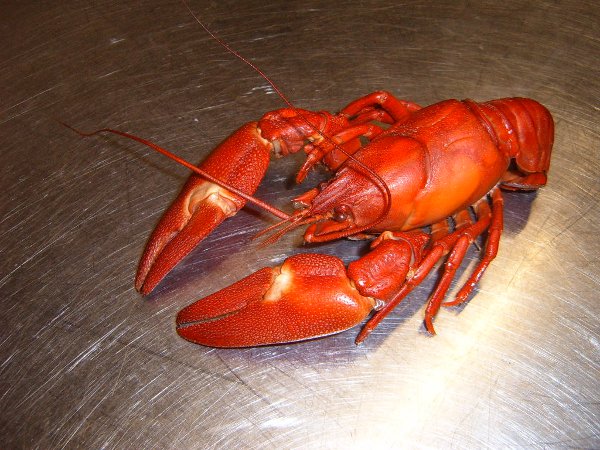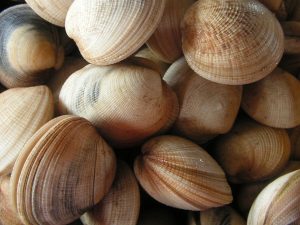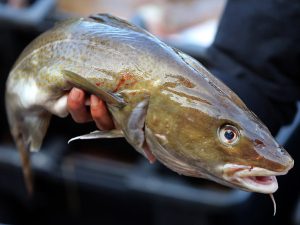Crayfish - introduction

“Water voles can drown in crayfish traps; you can modify your trap to allow water voles to escape, by cutting a hole in the roof” – Environment Agency
Contents
What are crayfish?
Called crawfish in the US, they are freshwater crustaceans related to lobsters, and there are two main species in UK – the native white-clawed crayfish (Austropotamobius pallipes), and the non-native American Signal crayfish (Pacifastacus leniusculus), which was introduced to Britain in the 1970s via dedicated farms, and subsequently escaped. There are a few other introduced species but they are not very widespread.

Signal crayfish are so called because they have white markings on their knuckles, similar to flags used by signalmen. Signal crayfish are bright red on the underside of their claws which makes them easy to identify and distinguish from the native crayfish. They can be up to 25cm long with claws extended. If you’re not sure whether what you’re looking at is a Signal or a native variety, look for the red claws – a sure sign that you’re looking at the Signal variety.
Trapping for food in the UK only involves the Signal species. The native species is now becoming rare. Both species live on the beds and in the banks of streams and rivers and are omnivorous, eating mainly dead creatures and plant debris.
The Signal crayfish can walk overland to establish itself in new waterways, and is now widespread throughout Britain.

What are the benefits of catching crayfish?
First – getting food from the wild is always a good idea from an environmental perspective (unless we deplete the resource – but this isn’t an issue here, as we’ll see later). Wild food requires no pesticides, fertilisers, hormones or genetic modification – in fact, no ecological interference at all.
Not only are they delicious to eat, but they are also nutritionally good for you – containing a good amount of high-quality protein and essential vitamins and minerals.
A significant benefit is in reducing their numbers. The invasive American Signal species is causing problems for both their native cousins and for British waterways. They out-compete their UK native counterparts because they are bigger, their eggs hatch earlier in the year, females lay up to 500 eggs (the native species lays around 200), and they are less fussy about what they eat. Also, the signal species carries a fungal disease (Aphanomyces astaci, commonly called the crayfish plague) that kills the native species (it’s not at all harmful to humans though). The American species burrow into the banks of rivers and streams to build their homes, causing erosion of the river banks.
The best way to make a significant impact on Signal crayfish populations is in a closed body of water like a lake or pond, where in-migration is limited. It is hard, particularly with small harvests, to have a big impact on crayfish populations in rivers, but every little helps!

What can I do?
Buying crayfish
If you want to eat them without catching them yourself, then you can buy UK-trapped crayfish. It’s worth noting that most crayfish sold in the UK is imported from China (even if it says ‘produced in the UK’ which they can get away with due to the flavouring process in the UK). So be aware of where you are buying from and try and support local trappers who are trying to keep the invasive species populations down.
Trapping crayfish
There are bylaws covering the trapping of crayfish, and what you can do depends on local circumstances – especially if there are native species in your area. Contact the Environment Agency to ask about your local circumstances. You will need a licence from the Environment Agency and tags on your trap for it to be legal.
You also need the landowner or waterway owner’s permission to trap crayfish.

The Environment Agency’s concerns are that if people are allowed to catch them for food, they might be sold, and because there is money to be made, some people might ‘seed’ rivers and streams that don’t have the signal variety, so that they can be harvested in the future. We share this concern, however, the Signal crayfish is now so widespread and in such large numbers, combined with the fact that it takes so long from ‘seeding’ to actually being able to harvest crayfish, that it is a very unlikely and unnecessary activity.
We encourage responsible trapping – either for your own consumption or for selling. This includes being very careful with what you catch – and not releasing it into other waterways. And also never ‘seeding’ or purposefully introducing Signal crayfish into waterways or lakes.

You need a licence to keep crayfish in this country – see DEFRA’s website – in case they escape into the wild. Signal Crayfish are so prolific now that it isn’t necessary to farm them, so this factsheet assumes that you’re not going to keep them, you’re just going to catch them from the wild.
Don’t put any you’ve caught into ponds or other bodies of water temporarily, as they could escape and colonise an area that doesn’t have them.
You can make your own trap. You can make a cylinder with chicken wire, up to a metre long, and bend the ends over to form a cone that crayfish can climb into but not out of. You can do the same with willow (see photo). Exact dimensions will be on your trapping licence application form from DEFRA.

Trapping crayfish is mainly a summer activity. In winter, they will be mostly hibernating in the river banks and may be a little trickier to catch.
The trap shouldn’t have an entrance of more than 95mm, because if there are otters in the area, they could get caught. You can get a hefty fine if you are caught using these illegal traps. If you have some already but the entrance is too big, you can make it smaller by following the guidelines here.
Bait the trap with something tasty (like a fish-head), plus a brick to weigh it down, then put it into a stream or lake you suspect has crayfish.
It is very important that your trap is well secured, you may want to tie it to something stable on the bank like a stake or tree. The main damage caused by trapping is from traps getting washed away and lost, these being a constant threat to wildlife on the riverbed, trapping not just crayfish but eels and other creatures.
Check in a few hours, or up to the next day. Anything other than signal crayfish, let go, and don’t leave a trap in a watercourse for more than 24 hours unchecked, in case something other than a crayfish gets trapped in it.
If you catch any native species, let them go – and report them to your local Environment Agency. In fact you shouldn’t be trapping there if you catch any native species, as they only occur where there isn’t an established Signal crayfish population.
Even if you catch small Signal crayfish, don’t put them back (in fact it is illegal to put them back, once caught). The Environment Agency in Scotland have urged fishermen to kill Signal crayfish on sight.
Take them out of the trap (keep fingers away from their pincers – although if they do pinch you, it doesn’t hurt that much apparently!), and keep them in tubs of tap water for a couple of days to purge them of any food in their intestines. Be sure to change the water regularly or put them in a bath with the tap running as they can easily run out of oxygen and die if left in stagnant water, or simply keep them in a chiller with some ice blocks. You can also just give them a good wash and use them straight away.

Cooking crayfish
Boil a large pan of water and tip them in – they are killed instantly. Bring back to the boil, then turn off the heat and leave in the hot water for another 10 minutes to cook in the residual heat. They turn pink and float when they are cooked, and look like mini-lobsters (which they are).
The commonly eaten parts are the tail and the claws, but all except the guts is edible and worth eating.
Pull and separate the head and tail. Pull off the legs, then grab the end of the flesh sticking out of the tail casing and pull. Sometimes there will be pink eggs – you can eat those too. But give it a bit of a rinse to get rid of all traces of intestines and food (take the black line out the middle of the body – that’s the guts). The most flavourful part is the shell body – great for bisque, stock or ‘crayfish butter’.
For the muscle meat from the claws, gently crack the shell with your teeth or a gentle hit with a hard object. Grab the end of the flesh and pull it out of the claw.
You can serve with rice, toast, mayonnaise and/or any number of sauces. It looks and tastes a bit like prawn. There are plenty of recipes out there. For a meal for one person, you’d probably need the meat of 5 decent sized of them. If crayfish are present in that stretch of water, you can easily catch 10 in a trap at the right time of year.

Specialist(s)
Thanks to Bob Ring of Crayfishbob for information.
The specialist(s) below will respond to queries on this topic. Please comment in the box at the bottom of the page.

Bob Ring, or ‘Crayfish Bob‘ is on a mission to remove Signal crayfish from UK waters and put them on people’s plates. He set up Crayaway crayfish removal service and has been trapping crayfish for over 15 years. He founded the National Institute of Crayfish Trappers, who aim to provide an environmentally sound legislative framework, to support research and development and to promote the trapping and consumption of non-native crayfish to assist in the conservation of freshwater habitats and species.







37 Comments
I saw a foodie programmme with Mary Berry catching signal crayfish. Will ham or bacon work as bait?
I have just purchased a trap and I am going to give it a go.
‘Will ham or bacon work as bait?’ Yes, definitely. Let us know how you get on.
Thanks Dave, it’s just that most articles I read say fish heads, guts etc otherwise results will be relatively poor. I don’t have access to lots of that, unless I start going to a fishmonger!!
I have applied to the EA for permission and tags and can’t wait to get started. Are they in most rivers, fast / slow flowing shallow / deep, I have red gravel bottom is best which suits the Salisbury area.
Thanks.
…… as a kid I remember fishing for crayfish in a river next to a park in Salisbury, there were loads hiding in the wooden shuttering holding up the bank. In those days I was catching the native Crayfish there, now all probably gone. (I used to release them!!)
Yes, any fishmonger would give you old fish bits, I’m sure. I guess they’d be more used to the smell of fish – but not necessarily, as most fish you get will be seafish. Friends at Redfield used to catch them with anything meaty really. I don’t think they’d turn their noses up at meat of any sort.
Hi, I am having trouble getting fresh fish heads etc, so could I use wild caught rabbit?
yes, see above – they’ll go for any meat, but it’s assumed that they’ll go for fish because that’s what they’re used to. Anyone with any experience of catching them with anything but fish?
Thanks, it would be interesting to see if anyone has had any success with meat.
I’ve seen it done on the TV with bacon. There is a season (not winter) but what are the start dates and finish? I have had a net out as a trial but no luck!
Iv been catching the signals for the last five years. I actually use a piece of raw chicken breast tied to a fishing line, (no hook) on a bamboo cane and throw it in. Make sure it hits the bottom of the river, canal etc and watch the line not the rod. When the line moves off, the bait is being carried away by a crayfish so I whip them up and out onto the bank before they let go. This technique is successful 95% of the time as a one clawed cray can sometimes let go on the way out. I once went with a friend and using a rod each we landed over 500 crayfish from one 100 yard stretch of the Manchester ship canal.
500! 100 metres! Manchester Ship Canal? gob well and truly smacked.
Hi, once cooked how long does the meat last if refrigerated/frozen?
Hi. Thanks for all the advice but I have what might be a silly question. Can they be eaten if they’re caught out of a canal? I just imagined that they could only be eaten if caught from really clean water out in the sticks. I’m from leicester and there are a lot of industrial buildings along parts of the canal. Cheers in advance.
As far as I know, that’s fine. You keep them in fresh water for 24 hours to flush them out before cooking. But I think that if the canal can support crayfish at all, it can’t be that contaminated. If someone knows differently, please let us know, but I think it’s fine.
Cheers Dave. Thanks for that. Better get my license and a trap then. My kids are going to love this.
About the bait, I have used bacon, pork bits or chicken with equal success. The best meat are the one that has gone-off; the smell of decaying meat is irresistable to them. I do not use a trap but employ the same method as Feral – a rod, a line with piece of meal at the end. All I need to do is to drop the line to the bottom, wait 30 secs, raise it gently to check if crayfish holding onto the meat; if so, pulling it close to surface and place a net (kiddies pond net will do) beneath it and that’s it.
In Northamptonshire, catching half a bucket (ie about 70 crayfish) within 40 mins is not uncommon.
Hi everybody, The best bait I have found is dog or cat food. They love it the cheap smelly stuff nothing to expensive! Evan dry food works well Put a handful in the trap.
Tuna flavoured cat food, flakes from pouches. I used it to attract signal crayfish in a small stream off the Thames. I was making a film of them and they readily came to a shallow gravelly area I baited with it.
Feral, Where on the canal have you been successful? I have tried near Barton Bridge and found noting in my Pot. Want to find somewhere as the kids want to catch something themselves. I have considered the pots to be the possible issue (however they do seem to be the standard size for the licence.
Is there a “season” applicable to catching crayfish? The licence application asks for the months in which trapping is planned but I cannot find any reference to a season.
The river is metres from my front door and access easy so if possible (subject to water levels) all year would be my choice.
Andrew, the season is best from June through November….but if you put “all year round” on the application form then you are fully covered.
I have EA licence. But not single fishery gives a permission to trap crayfish . Is useless .
A fishery is likely to say no to just a few traps. They want the crayfish cleared quickly and in large numbers – lots of traps. Maybe that’s one problem? I don’t know how many traps you have.
The EA licences are for specific places. It helps to check with the landowners before applying. But are there other waters that you can access as a from a footpath or anything? It’s hard to comment without knowing a bit more detail like; where you are.
There is plenty of talk about Cray Fishing in the canals. I have spoken to Helen at Canal Trust today and She advised that they do NOT allow trapping on ANY waters owned and managed by Canal Trust. Catching on a Hand Line or Rod is not trapping.
I am looking for how to find and permits with are land is allowed to catch a Signal crayfish. I don’t have such a land, and here I’m stuck to register for a licence. Where and how to find permit, and landlords to get permit for crayfishing 🙁 I was researching for so long and it is so crazy hard. Please any chan e to get a helpful advice?
Regards
Nadine
Nadine – not sure what your exact query is – could you clarify (there’s info on licences etc. in the article).
Oh no, another site telling me that crayfish will hurl themselves out of the water in great numbers the minute you look at them. I’ve spent a year trying to catch a single crayfish on a Kent river (and two other locations) and failed. NOT ONE. Everyone says they live everywhere and they are blindingly easy to catch, yet I’ve tried every bait, three types of trap, different times of day, of year; nothing. Nada. Zilch. Although I have caught a few eels, which I’ve put back.
I have now officially given up trying.
John – you must be jinxed. First time we tried, we put a home-made trap in a stream (in Buckinghamshire). Forgot what we used as bait, but got about 20 over the course of a few days. Maybe beginners’ luck? I’m guessing lots of people here have caught quite a few though.
I have my own stretch of river with signal crayfish and can almost net them out. It is not suitable for a trap at present, however when I was in the river a few days back they were crawling over my waders.
Will be back to netting in a month or two – my largest was almost 10″ (25cm).
If anyone has had any luck anywhere in mid- or west Kent, please let me know. Either I really am jinxed, or mid Kent is the only place in Britain with no crayfish.
John Holland, what bait are you using?
Last night, I took the fat from cooking a chicken and spread it on half a slice of bread, folded that in half, attached to the next and dropped in at around 10:30. Within a couple of minutes there were three or four there and by 11:30 I had 40 or so ranging from 50mm to around 160mm long. And there were still more around.
A couple of nights before, I used pork fat, with similar results.
If that bait does not work – you may be in a signal free zone!
John Holland,
I am using “Earls Tender Pate” dog food from Aldi. Cost 39p a tin. Stab a few very small holes all round the container so the scent filters out.
I empty my traps once a day and always have 10+ in each trap.
Have either of you trapped in Kent?
As for bait, I’ve tried most things, often either cat food, fish remains or rabbit offal. Either the rivers here are signal free , or I really am jinxed.
Hey John,
I have not trapped Kent but if you have used all those baits and there was Signal Cray they would have been caught.
I trap Oxfordshire and have had loads
John,
My area is to the West of London, so not Kent. I have tried fish and meats at times with very limited (or no) success – even smoked salmon! Then once I went to pork fat – I am on a low fat diet so it is all cut off, it totally changed 10 of them within minutes on a single flat net.
Fry up some bacon and use the run off fat on bread and see what happens.
If that fails, then you are probably, as you suggest, signal free!
Late at night, drop the net in and wait – if I leave mine over night, the signals all wander off! I can stand and watch by torch light as then skirt round and finally venture on.
Hey john, went fishing for carp in local lake near us with kids, and just reeled in and there was a crayfish clamped onto a carp pellet .never seen one before.kids thought was a big scorpion.
Fantastic ! I have trapped, ferreted, shot and long netted rabbits for years but now retired and taken up salt water fishing form the shore. This will serve both as goos bait and my own consumption very well. I have an ANC in wildlife and game management and countryside conservation so all this comes together very well. If anyone lives in Cheshire UK I would value some advice on locations when I recieve my trapping licence.
See you out there maybe 🙂
Ted